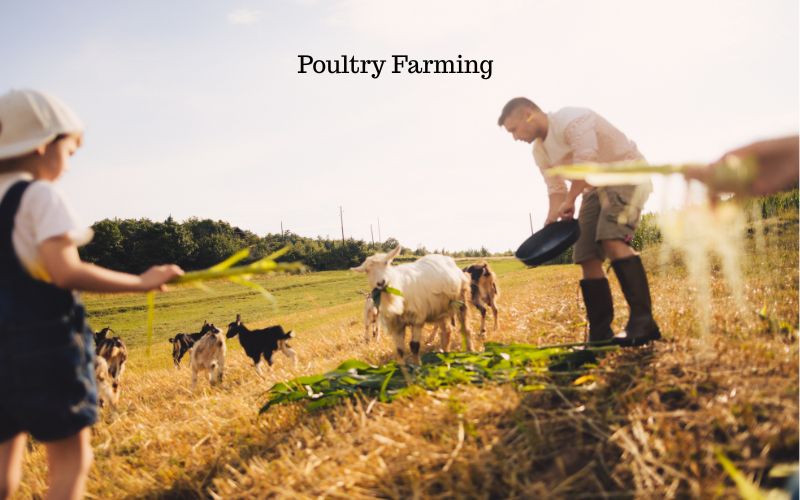
Are you planning to start a poultry farm business in India? It is a rewarding venture indeed. The rising demand for chicken and eggs has made poultry farming the fastest-growing industry in India. As the world's third-largest producer of eggs and sixth-largest producer of chicken meat, India offers future business owners a profitable opportunity. You must be wondering how to get started. Don’t worry about that because this guide will help you set up your poultry farm business in India.
Understanding the Poultry Farm Business in India
Understanding the Indian poultry market's environment is essential before beginning the setup procedure. In 2023, the size of the Indian poultry market was INR 2,099.2 billion. The market is anticipated to develop at a compound annual growth rate (CAGR) of 9.16% from 2023 to 2032, reaching INR 4,620.7 billion. Here are some important figures:
- Production: India ranks among the world's top producers of chicken meat and eggs.
- Growth: Over the past few decades, the Indian poultry market has grown steadily due to rising per capita income and shifting dietary preferences.
- Consumption: The amount of chicken meat and eggs consumed domestically is continuously increasing.
- Organized vs. Unorganized Sector: Both the organized (commercial farms) and unorganized (backyard farming) sectors make up India's poultry industry. This is because of its superior efficiency and quality control, the organized sector is taking over the market more and more.

Growth Factors in Poultry Farm Business in India
Investing in a Poultry farm could be a great idea because it involves lower investment with higher potential for growth. Here’s a breakdown of growth drivers in the poultry farm business in India:
Strong Demand and Expanding Market
You're entering a market that has a strong base. Due to India's enormous and continuously expanding population, there is a persistent need for reasonably priced protein sources like poultry. This demand will only grow stronger as earnings rise and more people learn about the nutritional advantages.
Also Read: How do you set up and register an e-commerce company in India?
Reasonably Fast Returns
Poultry farming, particularly the production of broiler (meat), offers a quicker turnaround than certain other agricultural endeavors that may take a long time to realize profits. In about 6–8 weeks, broilers can achieve market weight. This enables you to generate revenue more quickly by having several production cycles in a single year.
Reduced Startup Cost
Establishing a chicken farm can be less expensive than starting many other kinds of enterprises or even other types of agriculture, even if it still involves investment. Often, you can begin on a lesser scale and work your way up as your company develops and you acquire more expertise.
High Potential for Profit
Poultry farming may be quite profitable if you run your farm effectively, particularly regarding feed costs, which account for a significant portion of the costs. Good returns on your investment are a result of the high demand and relatively short manufacturing cycles.
Simple Sales and Marketing
As chicken and eggs are daily essentials, marketing and selling them is not too difficult. Local markets, eateries, shops, or even specific customers can be your goal. You can reach the people who need your items in a variety of ways.
Also Read: 30 Most Profitable Franchise Businesses in India
Challenges to Consider:
- Feed Costs: Price fluctuations for essential feed materials, such as soybean and maize, continue to be a major worry.
- Disease Outbreaks: Disease outbreaks have the potential to cause large losses in the poultry sector.
- Supply Chain Inefficiencies: Poor transportation and cold storage infrastructure might still be a problem.
- Waste Management: An essential environmental factor is the appropriate disposal of poultry waste.
Step-by-Step Guide to Setting Up Your Poultry Farm
This comprehensive guide is all you need to step into a poultry farm business in India. Let’s dive into these steps to understand how you can build a poultry farm business in India.
Plan a Business Strategy
You need to have a very strong business plan to build a solid foundation for your business. Developing a business plan may include many things, like financial planning, choosing if you want to focus on producing layers (eggs), broilers (meat), or both. Everyone has different needs and market conditions. A brief description of the poultry items that you want to sell. Recognize the competitors, current prices, and the demand for poultry goods in your target market. Find possible clients (restaurants, merchants, wholesalers, and individual customers). Having a well-defined plan will help you get finance and steer clear of expensive mistakes.
Securing Land and Location
When considering a poultry business, it is crucial to secure a suitable location. Choose if you want to own or rent the land. Make sure you fulfill all legal requirements. To find a location and land, you can consider factors like ease of access, good road connectivity makes it simple to move inputs and outputs. It's critical to have a dependable supply of pure water. Supply of electricity, required for ventilation, lighting, and other devices. Distance from Residential Areas to prevent possible complaints about odor and noise.
Also Read: How to Start a Small Business - Detailed Guide
Investment Plan
Starting a chicken farm involves a large cost for land, building materials, equipment, and startup expenses. Poultry farming loans are available from several Indian banks and financial institutions. Furthermore, subsidies are offered through programs such as the NABARD Poultry Venture Capital Fund. Generally speaking, interest rates fall between 8% and 12%. Here is an approximate cost breakdown:
- Purchase of Land: ₹2–5 lakhs (depending on region)
- Infrastructure (Water Supply, Equipment, Shed): ₹3–8 lakhs
- 1000 chicks at a cost of ₹30–50 each: ₹30,000–50,000
- Feed Expenses: ₹1.5–2 lakhs per month for 1000 birds.
- Healthcare & Vaccinations: ₹20,000–50,000
- Labor and Other Expenses: ₹50,000–1 lakh
Sources of Funding
-
Government Subsidies: NABARD (National Bank for Agriculture and Rural Development) offers poultry farming subsidies.
-
Bank Loans: Many banks provide loans under agricultural finance schemes.
-
Self-funding: If you have savings, that’s a great way to start without debt.
Obtain the Licenses and Permits You Need
It is crucial to comply with the legal requirements to operate this business. Submit a license application to the Department of Animal Husbandry and Dairying in your district. Obtain State Pollution Control Board permission and local building approvals to ensure environmental compliance.
Set Health and Disease Management
If diseases are not properly controlled, they can destroy a whole poultry farm. Adhere to these guidelines:
- Vaccinate the chick on schedule.
- Keep the agricultural environment sanitary and hygienic.
- Check for common poultry diseases such as bird flu and Newcastle disease regularly.
Feed Management
Give your birds a nutritionally balanced food that meets their individual needs at various growth stages. For advice on creating the ideal feed mix, speak with poultry experts. Purchase ready feed or premium feed ingredients from reliable vendors. Feed should be stored correctly to avoid contamination and spoiling. Make sure to stick to a regular feeding schedule.
Also Read: 15 Unique Business Ideas in Villages
Promote Your Products
Create a marketing plan to connect with potential clients. To sell your goods, make use of neighborhood markets, grocery stores, eateries, and internet marketplaces. One way to create a loyal customer base is to develop a brand and provide constant quality. Create effective methods of distribution to get your goods into the marketplace. This could involve selling directly to customers or supplying wholesalers, merchants, eateries, or processing facilities.
The key trends:
- Vertical Integration: One business now controls several production phases in the broiler chicken sector, which is getting more and more vertically integrated.
- Growing Demand for Organic Poultry: People are looking for poultry products that are organic and free of antibiotics.
- Contract Farming: It is a growing business concept in which businesses give farmers technical assistance and inputs, guaranteeing constant quality and lowering farmers risks.
- Growing Demand for Processed Poultry: People's lives tend to depend increasingly on easy-to-cook protein sources like poultry as more people relocate to urban areas.
- Government Policies and Support: The industry is being boosted by programs like as financial aid, subsidies, and technology support.
- Technological Advancements: Automation is increasing productivity and cutting expenses in hatcheries, feeding, and disease control.
- Export Potential: India is increasingly exporting poultry, mostly eggs and processed chicken, to the Middle East and Southeast Asia.
- Technological Advancements: Farmers can now watch their flocks in real-time, enabling early intervention and improved resource management, through techniques that use sensors, cameras, and data analytics.
With this comprehensive step-by-step guide, you have all the information needed to start your poultry business in India. A well-planned strategy, a significant investment, and careful management can help you build a profitable business. So, are you ready to build your business and bring your idea to life?

